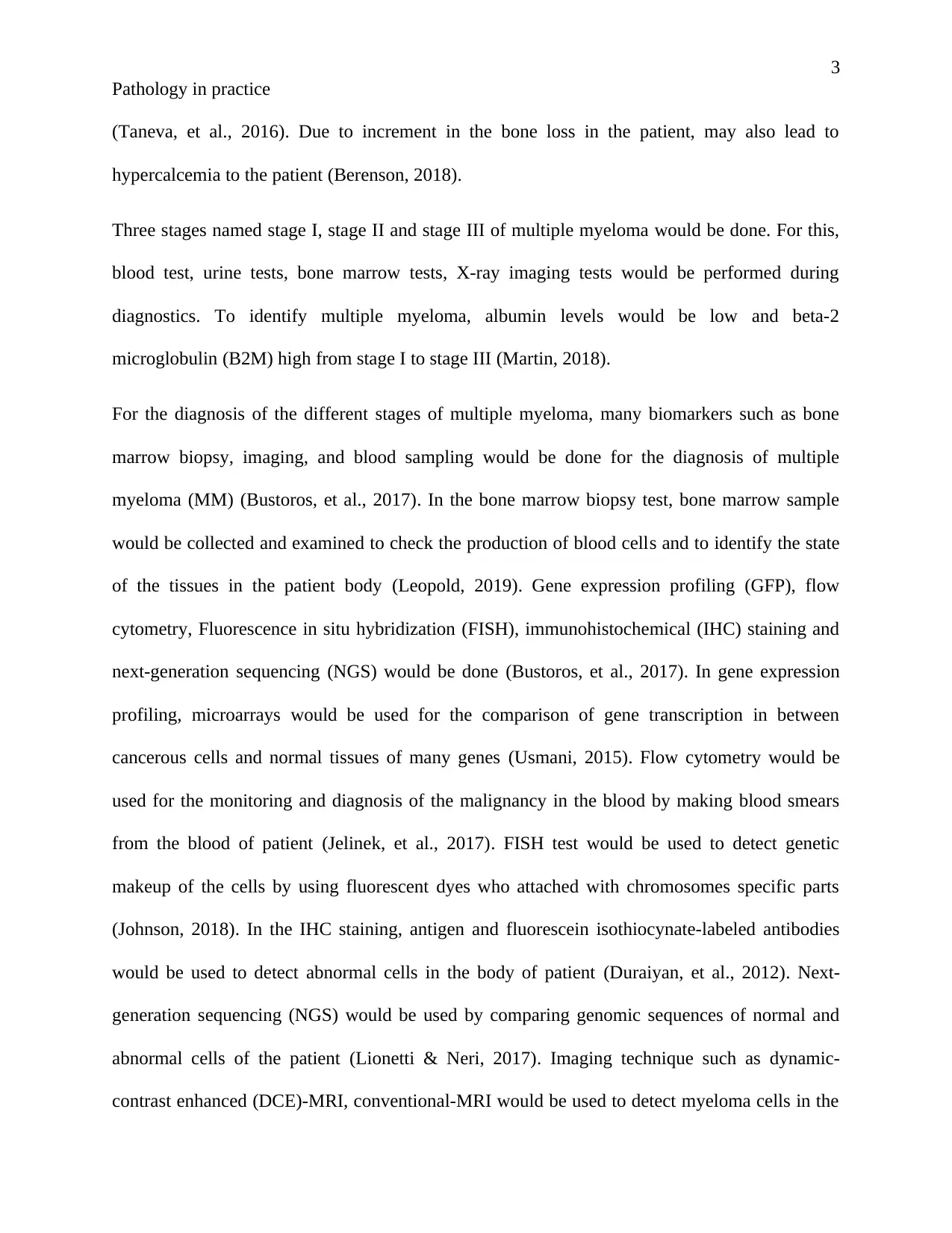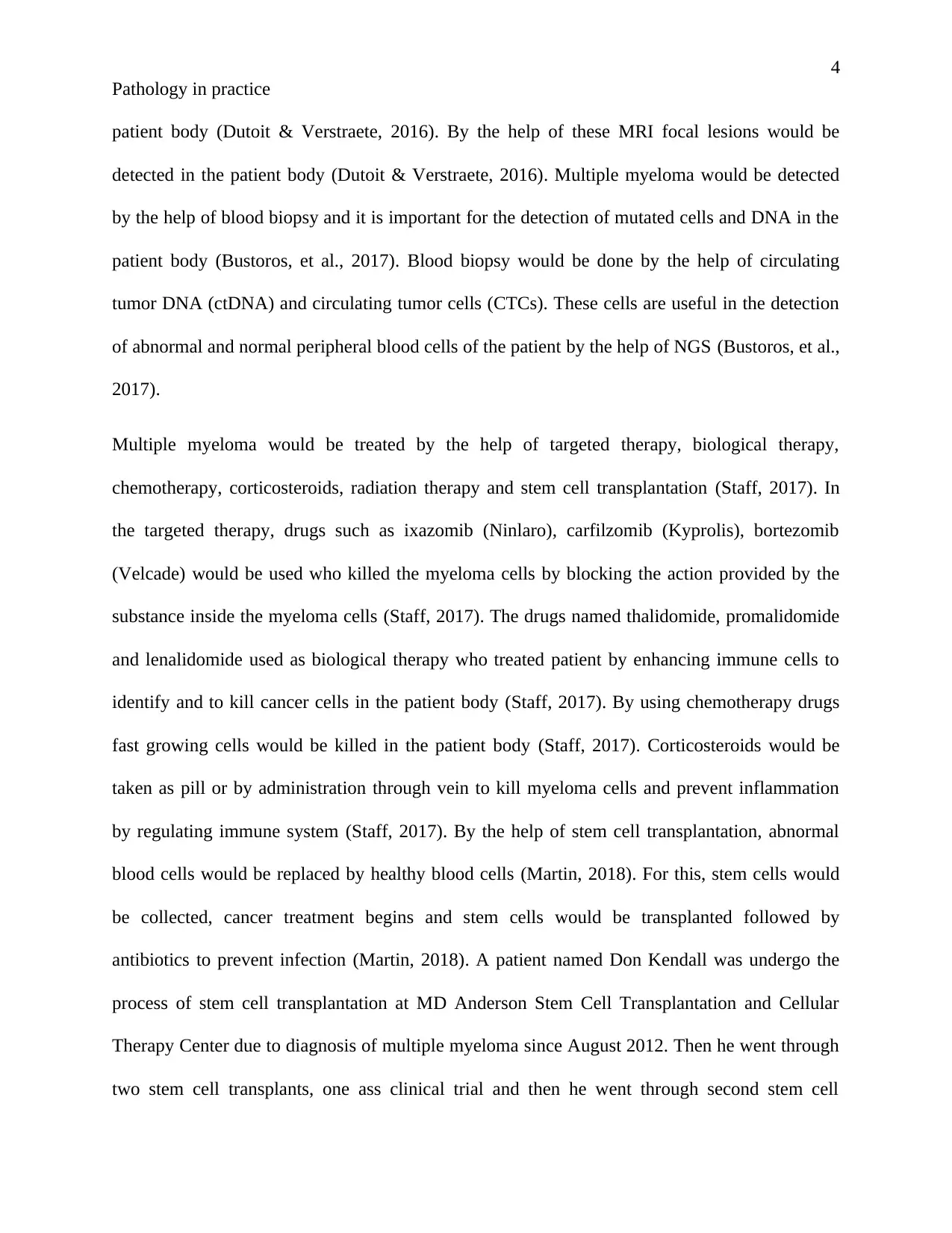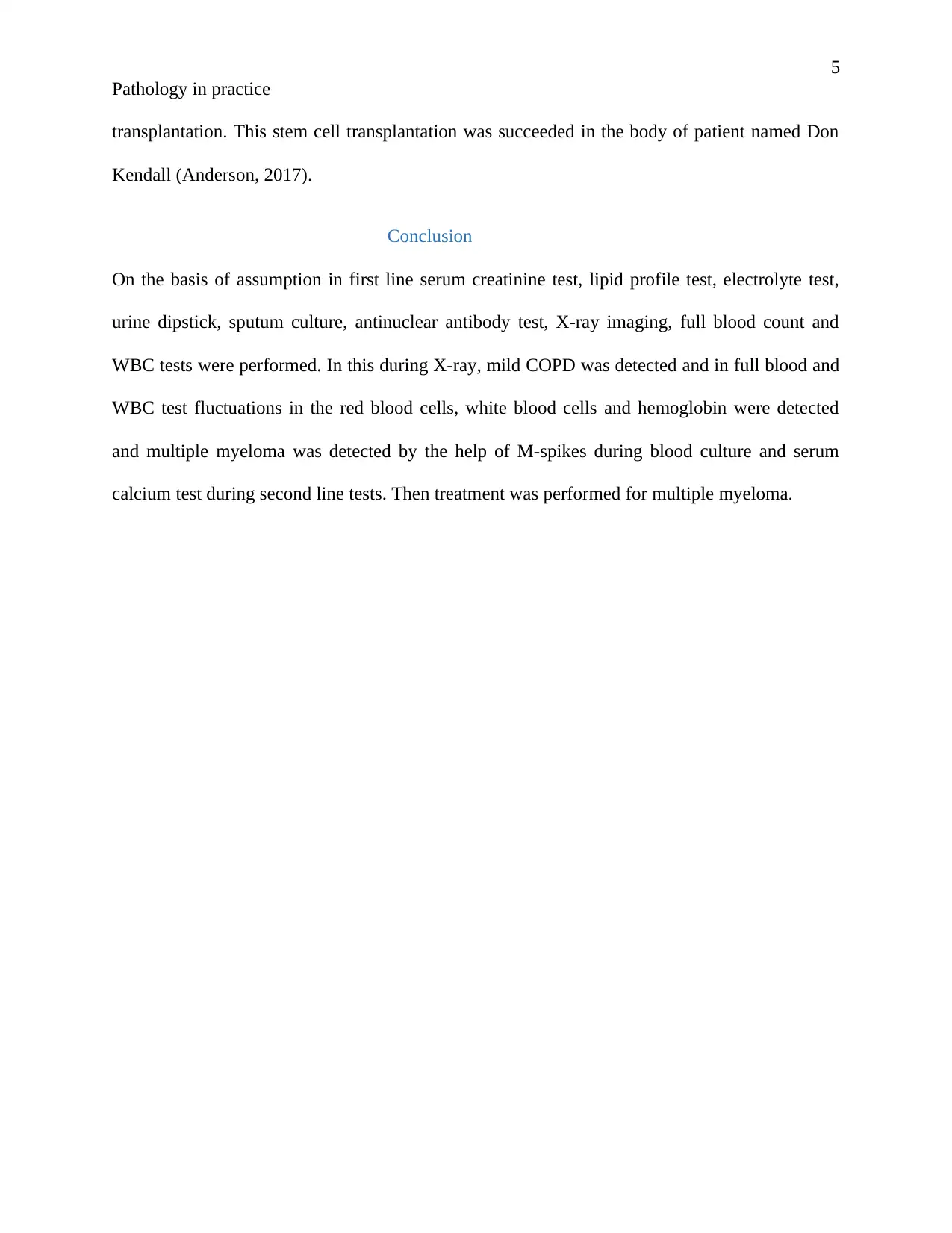Case Study of Multiple Myeloma
VerifiedAdded on 2023/03/17
|10
|2086
|100
AI Summary
This case study explores the diagnosis, treatment, and prognosis of a patient with multiple myeloma, a type of cancer that affects white blood cells. It discusses the symptoms, diagnostic tests, and various treatment options available for managing the disease.
Contribute Materials
Your contribution can guide someone’s learning journey. Share your
documents today.

0
Pathology in practice
Pathology in practice
Case study for patient having multiple myeloma
MAY 6, 2019
Students Details:
Pathology in practice
Pathology in practice
Case study for patient having multiple myeloma
MAY 6, 2019
Students Details:
Secure Best Marks with AI Grader
Need help grading? Try our AI Grader for instant feedback on your assignments.

1
Pathology in practice
Contents
Case Study of the patient having multiple myeloma.......................................................................2
Conclusion.......................................................................................................................................6
References.......................................................................................................................................7
Pathology in practice
Contents
Case Study of the patient having multiple myeloma.......................................................................2
Conclusion.......................................................................................................................................6
References.......................................................................................................................................7

2
Pathology in practice
Case Study of the patient having multiple myeloma
Multiple myeloma is the cancer which causes infections in the part of blood named white blood
cells (Staff, 2017). This multiple myeloma occurs when white blood cells become cancerous and
starts growing rapidly in bone marrow and lead to formation of abnormal proteins such as
monoclonal immunoglobin (Barhum, 2018).
In the multiple myeloma, decrement in red blood cells, white blood cells and haemoglobin would
be diagnosed (Martin, 2019). Erythrocytes sedimentation would be increased in the patient body
(Murrell, 2018). In the IgG monoclonal gammopathy, amount of monoclonal gamma
immunoglobin would be increased in the blood (Fanning & Hussein, 2018).
In the patient having multiple myeloma, malignant plasma cells would produce M-protein named
IgG and these cells would be determined by the help of urine test (Schapira, et al., 2018).
Malignant plasma cells secreted cytokines CXCL12, CCL5, and CXCL10 (Lima, et al., 2017)
and plasmacytomas (Berenson, 2018). Then these cytokines and plasmacytomas leads to the
activation of osteoclasts and suppression of osteoblasts and lead to development of osteolytic
lesions in spine, pelvis, ribs humerus, skull and femur (Berenson, 2018). Due to suppression of
erythropoiesis or kidney diseases, leads to the development of anemia in the patient body
(Berenson, 2018). Monoclonal gammopathy of IgG kappa was identified by using M-spikes. It
was done to identify multiple myeloma due to abnormal protein (Staff, 2017). Hypercalcemia
occurred due to over activeness of parathyroid glands and multiple myeloma where secretion of
calcium in the blood increased in excess amount (Staff, 2018). Due to excess amount of calcium
in the patient, kidney would not be able to excrete suitable amount of calcium outside the body.
It may lead to kidney diseases such as renal failure to the patient having multiple myeloma
Pathology in practice
Case Study of the patient having multiple myeloma
Multiple myeloma is the cancer which causes infections in the part of blood named white blood
cells (Staff, 2017). This multiple myeloma occurs when white blood cells become cancerous and
starts growing rapidly in bone marrow and lead to formation of abnormal proteins such as
monoclonal immunoglobin (Barhum, 2018).
In the multiple myeloma, decrement in red blood cells, white blood cells and haemoglobin would
be diagnosed (Martin, 2019). Erythrocytes sedimentation would be increased in the patient body
(Murrell, 2018). In the IgG monoclonal gammopathy, amount of monoclonal gamma
immunoglobin would be increased in the blood (Fanning & Hussein, 2018).
In the patient having multiple myeloma, malignant plasma cells would produce M-protein named
IgG and these cells would be determined by the help of urine test (Schapira, et al., 2018).
Malignant plasma cells secreted cytokines CXCL12, CCL5, and CXCL10 (Lima, et al., 2017)
and plasmacytomas (Berenson, 2018). Then these cytokines and plasmacytomas leads to the
activation of osteoclasts and suppression of osteoblasts and lead to development of osteolytic
lesions in spine, pelvis, ribs humerus, skull and femur (Berenson, 2018). Due to suppression of
erythropoiesis or kidney diseases, leads to the development of anemia in the patient body
(Berenson, 2018). Monoclonal gammopathy of IgG kappa was identified by using M-spikes. It
was done to identify multiple myeloma due to abnormal protein (Staff, 2017). Hypercalcemia
occurred due to over activeness of parathyroid glands and multiple myeloma where secretion of
calcium in the blood increased in excess amount (Staff, 2018). Due to excess amount of calcium
in the patient, kidney would not be able to excrete suitable amount of calcium outside the body.
It may lead to kidney diseases such as renal failure to the patient having multiple myeloma

3
Pathology in practice
(Taneva, et al., 2016). Due to increment in the bone loss in the patient, may also lead to
hypercalcemia to the patient (Berenson, 2018).
Three stages named stage I, stage II and stage III of multiple myeloma would be done. For this,
blood test, urine tests, bone marrow tests, X-ray imaging tests would be performed during
diagnostics. To identify multiple myeloma, albumin levels would be low and beta-2
microglobulin (B2M) high from stage I to stage III (Martin, 2018).
For the diagnosis of the different stages of multiple myeloma, many biomarkers such as bone
marrow biopsy, imaging, and blood sampling would be done for the diagnosis of multiple
myeloma (MM) (Bustoros, et al., 2017). In the bone marrow biopsy test, bone marrow sample
would be collected and examined to check the production of blood cells and to identify the state
of the tissues in the patient body (Leopold, 2019). Gene expression profiling (GFP), flow
cytometry, Fluorescence in situ hybridization (FISH), immunohistochemical (IHC) staining and
next-generation sequencing (NGS) would be done (Bustoros, et al., 2017). In gene expression
profiling, microarrays would be used for the comparison of gene transcription in between
cancerous cells and normal tissues of many genes (Usmani, 2015). Flow cytometry would be
used for the monitoring and diagnosis of the malignancy in the blood by making blood smears
from the blood of patient (Jelinek, et al., 2017). FISH test would be used to detect genetic
makeup of the cells by using fluorescent dyes who attached with chromosomes specific parts
(Johnson, 2018). In the IHC staining, antigen and fluorescein isothiocynate-labeled antibodies
would be used to detect abnormal cells in the body of patient (Duraiyan, et al., 2012). Next-
generation sequencing (NGS) would be used by comparing genomic sequences of normal and
abnormal cells of the patient (Lionetti & Neri, 2017). Imaging technique such as dynamic-
contrast enhanced (DCE)-MRI, conventional-MRI would be used to detect myeloma cells in the
Pathology in practice
(Taneva, et al., 2016). Due to increment in the bone loss in the patient, may also lead to
hypercalcemia to the patient (Berenson, 2018).
Three stages named stage I, stage II and stage III of multiple myeloma would be done. For this,
blood test, urine tests, bone marrow tests, X-ray imaging tests would be performed during
diagnostics. To identify multiple myeloma, albumin levels would be low and beta-2
microglobulin (B2M) high from stage I to stage III (Martin, 2018).
For the diagnosis of the different stages of multiple myeloma, many biomarkers such as bone
marrow biopsy, imaging, and blood sampling would be done for the diagnosis of multiple
myeloma (MM) (Bustoros, et al., 2017). In the bone marrow biopsy test, bone marrow sample
would be collected and examined to check the production of blood cells and to identify the state
of the tissues in the patient body (Leopold, 2019). Gene expression profiling (GFP), flow
cytometry, Fluorescence in situ hybridization (FISH), immunohistochemical (IHC) staining and
next-generation sequencing (NGS) would be done (Bustoros, et al., 2017). In gene expression
profiling, microarrays would be used for the comparison of gene transcription in between
cancerous cells and normal tissues of many genes (Usmani, 2015). Flow cytometry would be
used for the monitoring and diagnosis of the malignancy in the blood by making blood smears
from the blood of patient (Jelinek, et al., 2017). FISH test would be used to detect genetic
makeup of the cells by using fluorescent dyes who attached with chromosomes specific parts
(Johnson, 2018). In the IHC staining, antigen and fluorescein isothiocynate-labeled antibodies
would be used to detect abnormal cells in the body of patient (Duraiyan, et al., 2012). Next-
generation sequencing (NGS) would be used by comparing genomic sequences of normal and
abnormal cells of the patient (Lionetti & Neri, 2017). Imaging technique such as dynamic-
contrast enhanced (DCE)-MRI, conventional-MRI would be used to detect myeloma cells in the
Secure Best Marks with AI Grader
Need help grading? Try our AI Grader for instant feedback on your assignments.

4
Pathology in practice
patient body (Dutoit & Verstraete, 2016). By the help of these MRI focal lesions would be
detected in the patient body (Dutoit & Verstraete, 2016). Multiple myeloma would be detected
by the help of blood biopsy and it is important for the detection of mutated cells and DNA in the
patient body (Bustoros, et al., 2017). Blood biopsy would be done by the help of circulating
tumor DNA (ctDNA) and circulating tumor cells (CTCs). These cells are useful in the detection
of abnormal and normal peripheral blood cells of the patient by the help of NGS (Bustoros, et al.,
2017).
Multiple myeloma would be treated by the help of targeted therapy, biological therapy,
chemotherapy, corticosteroids, radiation therapy and stem cell transplantation (Staff, 2017). In
the targeted therapy, drugs such as ixazomib (Ninlaro), carfilzomib (Kyprolis), bortezomib
(Velcade) would be used who killed the myeloma cells by blocking the action provided by the
substance inside the myeloma cells (Staff, 2017). The drugs named thalidomide, promalidomide
and lenalidomide used as biological therapy who treated patient by enhancing immune cells to
identify and to kill cancer cells in the patient body (Staff, 2017). By using chemotherapy drugs
fast growing cells would be killed in the patient body (Staff, 2017). Corticosteroids would be
taken as pill or by administration through vein to kill myeloma cells and prevent inflammation
by regulating immune system (Staff, 2017). By the help of stem cell transplantation, abnormal
blood cells would be replaced by healthy blood cells (Martin, 2018). For this, stem cells would
be collected, cancer treatment begins and stem cells would be transplanted followed by
antibiotics to prevent infection (Martin, 2018). A patient named Don Kendall was undergo the
process of stem cell transplantation at MD Anderson Stem Cell Transplantation and Cellular
Therapy Center due to diagnosis of multiple myeloma since August 2012. Then he went through
two stem cell transplants, one ass clinical trial and then he went through second stem cell
Pathology in practice
patient body (Dutoit & Verstraete, 2016). By the help of these MRI focal lesions would be
detected in the patient body (Dutoit & Verstraete, 2016). Multiple myeloma would be detected
by the help of blood biopsy and it is important for the detection of mutated cells and DNA in the
patient body (Bustoros, et al., 2017). Blood biopsy would be done by the help of circulating
tumor DNA (ctDNA) and circulating tumor cells (CTCs). These cells are useful in the detection
of abnormal and normal peripheral blood cells of the patient by the help of NGS (Bustoros, et al.,
2017).
Multiple myeloma would be treated by the help of targeted therapy, biological therapy,
chemotherapy, corticosteroids, radiation therapy and stem cell transplantation (Staff, 2017). In
the targeted therapy, drugs such as ixazomib (Ninlaro), carfilzomib (Kyprolis), bortezomib
(Velcade) would be used who killed the myeloma cells by blocking the action provided by the
substance inside the myeloma cells (Staff, 2017). The drugs named thalidomide, promalidomide
and lenalidomide used as biological therapy who treated patient by enhancing immune cells to
identify and to kill cancer cells in the patient body (Staff, 2017). By using chemotherapy drugs
fast growing cells would be killed in the patient body (Staff, 2017). Corticosteroids would be
taken as pill or by administration through vein to kill myeloma cells and prevent inflammation
by regulating immune system (Staff, 2017). By the help of stem cell transplantation, abnormal
blood cells would be replaced by healthy blood cells (Martin, 2018). For this, stem cells would
be collected, cancer treatment begins and stem cells would be transplanted followed by
antibiotics to prevent infection (Martin, 2018). A patient named Don Kendall was undergo the
process of stem cell transplantation at MD Anderson Stem Cell Transplantation and Cellular
Therapy Center due to diagnosis of multiple myeloma since August 2012. Then he went through
two stem cell transplants, one ass clinical trial and then he went through second stem cell

5
Pathology in practice
transplantation. This stem cell transplantation was succeeded in the body of patient named Don
Kendall (Anderson, 2017).
Conclusion
On the basis of assumption in first line serum creatinine test, lipid profile test, electrolyte test,
urine dipstick, sputum culture, antinuclear antibody test, X-ray imaging, full blood count and
WBC tests were performed. In this during X-ray, mild COPD was detected and in full blood and
WBC test fluctuations in the red blood cells, white blood cells and hemoglobin were detected
and multiple myeloma was detected by the help of M-spikes during blood culture and serum
calcium test during second line tests. Then treatment was performed for multiple myeloma.
Pathology in practice
transplantation. This stem cell transplantation was succeeded in the body of patient named Don
Kendall (Anderson, 2017).
Conclusion
On the basis of assumption in first line serum creatinine test, lipid profile test, electrolyte test,
urine dipstick, sputum culture, antinuclear antibody test, X-ray imaging, full blood count and
WBC tests were performed. In this during X-ray, mild COPD was detected and in full blood and
WBC test fluctuations in the red blood cells, white blood cells and hemoglobin were detected
and multiple myeloma was detected by the help of M-spikes during blood culture and serum
calcium test during second line tests. Then treatment was performed for multiple myeloma.

6
Pathology in practice
References
American Cancer Society , 2018. What Is Multiple Myeloma?. [Online]
Available at: https://www.cancer.org/cancer/multiple-myeloma/about/what-is-multiple-
myeloma.html
Anderson, M., 2017. Multiple myeloma survivor finds success with stem cell transplants.
[Online]
Available at: https://www.mdanderson.org/publications/cancerwise/multiple-myeloma-stem-cell-
transplantation-clinical-trials.h00-159142089.html
Barhum, L., 2018. What is the first sign of multiple myeloma?. [Online]
Available at: https://www.medicalnewstoday.com/articles/322105.php
Berenson, J. R., 2018. Multiple Myeloma. [Online]
Available at: https://www.msdmanuals.com/en-in/professional/hematology-and-oncology/
plasma-cell-disorders/multiple-myeloma
Bustoros, M., Mouhieddine, T. H., Detappe, A. & Ghobrial, I. M., 2017. Established and Novel
Prognostic Biomarkers in Multiple Myeloma. [Online]
Available at: https://meetinglibrary.asco.org/record/138188/edbook#fulltext
Duraiyan, J., Govindarajan, R., Kaliyappan, K. & Palanisamy, M., 2012. Applications of
immunohistochemistry. Journal of Pharmacy & BioAllied Sciences, August.4(2).
Dutoit, J. C. & Verstraete, K. L., 2016. MRI in multiple myeloma: a pictorial review of
diagnostic and post-treatment findings. PMC, August, 7(4), pp. 553-569.
Pathology in practice
References
American Cancer Society , 2018. What Is Multiple Myeloma?. [Online]
Available at: https://www.cancer.org/cancer/multiple-myeloma/about/what-is-multiple-
myeloma.html
Anderson, M., 2017. Multiple myeloma survivor finds success with stem cell transplants.
[Online]
Available at: https://www.mdanderson.org/publications/cancerwise/multiple-myeloma-stem-cell-
transplantation-clinical-trials.h00-159142089.html
Barhum, L., 2018. What is the first sign of multiple myeloma?. [Online]
Available at: https://www.medicalnewstoday.com/articles/322105.php
Berenson, J. R., 2018. Multiple Myeloma. [Online]
Available at: https://www.msdmanuals.com/en-in/professional/hematology-and-oncology/
plasma-cell-disorders/multiple-myeloma
Bustoros, M., Mouhieddine, T. H., Detappe, A. & Ghobrial, I. M., 2017. Established and Novel
Prognostic Biomarkers in Multiple Myeloma. [Online]
Available at: https://meetinglibrary.asco.org/record/138188/edbook#fulltext
Duraiyan, J., Govindarajan, R., Kaliyappan, K. & Palanisamy, M., 2012. Applications of
immunohistochemistry. Journal of Pharmacy & BioAllied Sciences, August.4(2).
Dutoit, J. C. & Verstraete, K. L., 2016. MRI in multiple myeloma: a pictorial review of
diagnostic and post-treatment findings. PMC, August, 7(4), pp. 553-569.
Paraphrase This Document
Need a fresh take? Get an instant paraphrase of this document with our AI Paraphraser

7
Pathology in practice
Dutoit, J. C. & Verstraete, K. L., 2016. MRI in multiple myeloma: a pictorial review of
diagnostic and post-treatment findings. Insights into imaging, 10 May, 7(4), pp. 553-569.
Fanning, S. R. & Hussein, M. A., 2018. Monoclonal Gammopathies of Undetermined
Significance. [Online]
Available at: https://emedicine.medscape.com/article/204297-overview
Jelinek, T. et al., 2017. Current applications of multiparameter flow cytometry in plasma cell
disorders. Blood Cancer Journal, October.7(10).
Johnson, E., 2018. What Is a FISH Test in Multiple Myeloma?. [Online]
Available at: https://www.myelomacrowd.org/what-is-a-fish-test-in-multiple-myeloma/
Leopold, C., 2019. What does a bone marrow biopsy involve?. [Online]
Available at: https://www.medicalnewstoday.com/articles/312292.php
Lima, L. F.-d.-. et al., 2017. Multiple Myeloma Cells Express Key Immunoregulatory Cytokines
and Modulate the Monocyte Migratory Response. PMC, 27 June.Volume 4.
Lionetti, M. & Neri, A., 2017. Utilizing next-generation sequencing in the management of
multiple myeloma.. PubMed Weebsite, July, 17(7), pp. 653-663.
Martin, L. J., 2018. Multiple Myeloma Stages and Prognosis. [Online]
Available at: https://www.webmd.com/cancer/multiple-myeloma/multiple-myeloma-stages-
prognosis#1
Martin, L. J., 2018. Stem Cell Transplant for Multiple Myeloma. [Online]
Available at: https://www.webmd.com/cancer/multiple-myeloma/multiple-myeloma-stem-cell-
transplant#1
Pathology in practice
Dutoit, J. C. & Verstraete, K. L., 2016. MRI in multiple myeloma: a pictorial review of
diagnostic and post-treatment findings. Insights into imaging, 10 May, 7(4), pp. 553-569.
Fanning, S. R. & Hussein, M. A., 2018. Monoclonal Gammopathies of Undetermined
Significance. [Online]
Available at: https://emedicine.medscape.com/article/204297-overview
Jelinek, T. et al., 2017. Current applications of multiparameter flow cytometry in plasma cell
disorders. Blood Cancer Journal, October.7(10).
Johnson, E., 2018. What Is a FISH Test in Multiple Myeloma?. [Online]
Available at: https://www.myelomacrowd.org/what-is-a-fish-test-in-multiple-myeloma/
Leopold, C., 2019. What does a bone marrow biopsy involve?. [Online]
Available at: https://www.medicalnewstoday.com/articles/312292.php
Lima, L. F.-d.-. et al., 2017. Multiple Myeloma Cells Express Key Immunoregulatory Cytokines
and Modulate the Monocyte Migratory Response. PMC, 27 June.Volume 4.
Lionetti, M. & Neri, A., 2017. Utilizing next-generation sequencing in the management of
multiple myeloma.. PubMed Weebsite, July, 17(7), pp. 653-663.
Martin, L. J., 2018. Multiple Myeloma Stages and Prognosis. [Online]
Available at: https://www.webmd.com/cancer/multiple-myeloma/multiple-myeloma-stages-
prognosis#1
Martin, L. J., 2018. Stem Cell Transplant for Multiple Myeloma. [Online]
Available at: https://www.webmd.com/cancer/multiple-myeloma/multiple-myeloma-stem-cell-
transplant#1

8
Pathology in practice
Martin, L. J., 2018. Types of Multiple Myeloma. [Online]
Available at: https://www.webmd.com/cancer/multiple-myeloma/multiple-myeloma-types#1
Martin, L. J., 2019. Multiple Myeloma. [Online]
Available at: https://www.webmd.com/cancer/multiple-myeloma-symptoms-causes-treatment#1
Murrell, D., 2018. What does it mean if your ESR is high?. [Online]
Available at: https://www.medicalnewstoday.com/articles/323057.php
Schapira, L., Berek, J. S. & Chang, S. M., 2018. Multiple Myeloma: Diagnosis. [Online]
Available at: https://www.cancer.net/cancer-types/multiple-myeloma/diagnosis
Staff, M. C., 2017. Monoclonal gammopathy of undetermined significance (MGUS). [Online]
Available at: https://www.mayoclinic.org/diseases-conditions/mgus/symptoms-causes/syc-
20352362
Staff, M. C., 2017. Multiple myeloma. [Online]
Available at: https://www.mayoclinic.org/diseases-conditions/multiple-myeloma/symptoms-
causes/syc-20353378
Staff, M. C., 2017. Multiple myeloma. [Online]
Available at: https://www.mayoclinic.org/diseases-conditions/multiple-myeloma/diagnosis-
treatment/drc-20353383
Staff, M. C., 2018. Hypercalcemia. [Online]
Available at: https://www.mayoclinic.org/diseases-conditions/hypercalcemia/symptoms-causes/
syc-20355523
Pathology in practice
Martin, L. J., 2018. Types of Multiple Myeloma. [Online]
Available at: https://www.webmd.com/cancer/multiple-myeloma/multiple-myeloma-types#1
Martin, L. J., 2019. Multiple Myeloma. [Online]
Available at: https://www.webmd.com/cancer/multiple-myeloma-symptoms-causes-treatment#1
Murrell, D., 2018. What does it mean if your ESR is high?. [Online]
Available at: https://www.medicalnewstoday.com/articles/323057.php
Schapira, L., Berek, J. S. & Chang, S. M., 2018. Multiple Myeloma: Diagnosis. [Online]
Available at: https://www.cancer.net/cancer-types/multiple-myeloma/diagnosis
Staff, M. C., 2017. Monoclonal gammopathy of undetermined significance (MGUS). [Online]
Available at: https://www.mayoclinic.org/diseases-conditions/mgus/symptoms-causes/syc-
20352362
Staff, M. C., 2017. Multiple myeloma. [Online]
Available at: https://www.mayoclinic.org/diseases-conditions/multiple-myeloma/symptoms-
causes/syc-20353378
Staff, M. C., 2017. Multiple myeloma. [Online]
Available at: https://www.mayoclinic.org/diseases-conditions/multiple-myeloma/diagnosis-
treatment/drc-20353383
Staff, M. C., 2018. Hypercalcemia. [Online]
Available at: https://www.mayoclinic.org/diseases-conditions/hypercalcemia/symptoms-causes/
syc-20355523

9
Pathology in practice
Taneva, O. S., Taneva, B. & Selim, G., 2016. Hypercalcemia as a Cause of Kidney Failure: Case
Report. PMC, 15 June, 4(2), pp. 283-286.
Usmani, S. Z., 2015. WHAT IS THE ROLE OF GENE EXPRESSION PROFILING IN
MULTIPLE MYELOMA? HOW CAN IT HELP IN TAKING CARE OF MYELOMA PATIENTS
IN A BETTER WAY?. [Online]
Available at: http://www.managingmyeloma.com/knowledge-center/faq-library/862-what-is-the-
role-of-gene-expression-profiling-in-multiple-myeloma-how-can-it-help-in-taking-care-of-
myeloma-patients-in-a-better-way
Pathology in practice
Taneva, O. S., Taneva, B. & Selim, G., 2016. Hypercalcemia as a Cause of Kidney Failure: Case
Report. PMC, 15 June, 4(2), pp. 283-286.
Usmani, S. Z., 2015. WHAT IS THE ROLE OF GENE EXPRESSION PROFILING IN
MULTIPLE MYELOMA? HOW CAN IT HELP IN TAKING CARE OF MYELOMA PATIENTS
IN A BETTER WAY?. [Online]
Available at: http://www.managingmyeloma.com/knowledge-center/faq-library/862-what-is-the-
role-of-gene-expression-profiling-in-multiple-myeloma-how-can-it-help-in-taking-care-of-
myeloma-patients-in-a-better-way
1 out of 10
Your All-in-One AI-Powered Toolkit for Academic Success.
+13062052269
info@desklib.com
Available 24*7 on WhatsApp / Email
![[object Object]](/_next/static/media/star-bottom.7253800d.svg)
Unlock your academic potential
© 2024 | Zucol Services PVT LTD | All rights reserved.
